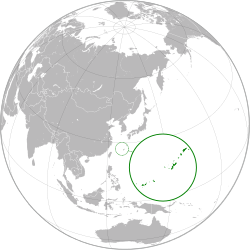Ryukyu Kingdom
| Ryukyu Kingdom | ||||||||||||||||||
| 琉球國 | ||||||||||||||||||
|
Tributary state of the Ming dynasty (1429–1644) Tributary state of the Qing dynasty (1644–1874) Vassal state of Satsuma Domain (1609–1872) Vassal state of the Empire of Japan (1872–1879) |
||||||||||||||||||
|
||||||||||||||||||
|
||||||||||||||||||
| Capital | Shuri | |||||||||||||||||
| Languages | Ryukyuan (native languages), Classical Chinese, Classical Japanese | |||||||||||||||||
| Religion | native Ryukyuan religion, Buddhism, Confucianism, Taoism | |||||||||||||||||
| Government | Monarchy | |||||||||||||||||
| King (國王) | ||||||||||||||||||
| • | 1429–1439 | Shō Hashi | ||||||||||||||||
| • | 1477–1526 | Shō Shin | ||||||||||||||||
| • | 1587–1620 | Shō Nei | ||||||||||||||||
| • | 1848–1879 | Shō Tai | ||||||||||||||||
| Sessei (摂政) | ||||||||||||||||||
| • | 1666–1673 | Shō Shōken | ||||||||||||||||
| Regent (國司, Kokushi) | ||||||||||||||||||
| • | 1751–1752 | Sai On | ||||||||||||||||
| Legislature | Shuri cabinet (首里王府), Sanshikan (三司官) | |||||||||||||||||
| History | ||||||||||||||||||
| • | Unification | 1429 | ||||||||||||||||
| • | Satsuma invasion | April 5, 1609 | ||||||||||||||||
| • | Reorganized into Ryukyu Domain | 1875 | ||||||||||||||||
| • | Annexed by Japan | March 11, 1879 | ||||||||||||||||
| Area | 2,271 km² (877 sq mi) | |||||||||||||||||
|
||||||||||||||||||
| Today part of |
|
|||||||||||||||||
The Ryukyu Kingdom (Japanese: 琉球王国 Ryūkyū Ōkoku; Okinawan: 琉球國 Ruuchuu-kuku; Middle Chinese: Ljuw-gjuw kwok; historical English name: Lewchew, Luchu, and Loochoo) was an independent kingdom that ruled most of the Ryukyu Islands from the 15th to the 19th century. The kings of Ryukyu unified Okinawa Island and extended the kingdom to the Amami Islands in modern-day Kagoshima Prefecture, and the Sakishima Islands near Taiwan. Despite its small size, the kingdom played a central role in the maritime trade networks of medieval East and Southeast Asia.
In the 14th century, small domains scattered on Okinawa Island were unified into three principalities: Hokuzan (北山?, Northern Mountain), Chūzan (中山?, Central Mountain) and Nanzan (南山?, Southern Mountain). This was known as the Three Kingdoms or Sanzan (三山, Three Mountains) period. Hokuzan, which constituted much of the northern half of the island, was the largest in terms of land area and military strength, but was economically the weakest of the three. Nanzan constituted the southern portion of the island. Chūzan lay in the center of the island, and was economically the strongest. Its political capital at Shuri, Nanzan was adjacent to the major port of Naha and Kume-mura, the center of traditional Chinese education. These sites, and Chūzan as a whole, would continue to form the center of the Ryukyu Kingdom until its abolition.
...
Wikipedia



